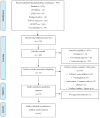The Risk Factors Related to Voice Disorder in Teachers: A Systematic Review and Meta-Analysis
- PMID: 31574928
- PMCID: PMC6801660
- DOI: 10.3390/ijerph16193675
The Risk Factors Related to Voice Disorder in Teachers: A Systematic Review and Meta-Analysis
Abstract
Background and Objectives: Identifying the risk factors of teachers' voice disorders is very important for preventing voice disorders and the recurrence of them. This meta-study identified risk factors associated with teachers' voice disorders through systematic review and meta-analysis and provided basic data for preventing them. Materials and Methods: This study collected literature on the risk factors of teachers' voice disorders using six databases (i.e., CINAHL, EBSCO, PUBMED, SCOPUS, Web of Science, and Springer Link). Search was limited to studies published between 1 January 2000 and 15 October 2018, and a total of 16 publications were selected for the analysis of this study. The quality of selected literature was assessed using the "Standard Quality Assessment Criteria for Evaluating Primary Research Papers from a Variety of Fields". The effect size was analyzed by odds ratio and 95% confidence interval. Results: The results of the quality assessment ranged from 20 to 24 points with six strong studies and ten good studies. The meta-analysis showed that gender, upper airway problems, caffeine consumption, speaking loudly, number of classes per week, and resignation experience due to voice problems were the major risk factors of teachers' voice disorders. On the other hand, age, number of children, drinking, physical activity, smoking, water intake, singing habits, duration of teaching, perception of noise inside the school, number of classes per day, noise assessment inside the classroom, and perception of technology and instruments inside the workplace were not significantly related to voice disorders. Conclusions: Longitudinal studies should be conducted in the future to confirm causality between voice disorders and risk factors based on the results of this study.
Keywords: meta-analysis; occupational environment; risk factors; systematic review; teachers; voice disorders.
Conflict of interest statement
The authors declare no conflict of interest.
Figures






Similar articles
-
Prevalence and Risk Factors of Voice Problems Among Primary School Teachers in India.J Voice. 2017 Jan;31(1):117.e1-117.e10. doi: 10.1016/j.jvoice.2016.03.006. Epub 2016 Jun 27. J Voice. 2017. PMID: 27363867
-
Influence of Noise Resulting From the Location and Conditions of Classrooms and Schools in Upper Egypt on Teachers' Voices.J Voice. 2019 Sep;33(5):802.e1-802.e9. doi: 10.1016/j.jvoice.2018.03.003. Epub 2018 May 3. J Voice. 2019. PMID: 29731381
-
School teachers' vocal use, risk factors, and voice disorder prevalence: guidelines to detect teachers with current voice problems.Folia Phoniatr Logop. 2011;63(4):209-15. doi: 10.1159/000316310. Epub 2010 Oct 12. Folia Phoniatr Logop. 2011. PMID: 20938203
-
The Prevalence of Voice Disorders and the Related Factors in University Professors: A Systematic Review and Meta-Analysis.J Voice. 2024 Sep;38(5):1103-1114. doi: 10.1016/j.jvoice.2022.02.017. Epub 2022 Apr 11. J Voice. 2024. PMID: 35422355
-
The Risk Factors of Voice Disorders in Non-University Teachers: A Systematic Review and Meta-Analysis.J Voice. 2024 Dec 5:S0892-1997(24)00372-2. doi: 10.1016/j.jvoice.2024.10.023. Online ahead of print. J Voice. 2024. PMID: 39643556 Review.
Cited by
-
The prevalence and risk factors for perceived voice disorders in public school teachers.Laryngoscope Investig Otolaryngol. 2022 Apr 27;7(3):790-798. doi: 10.1002/lio2.803. eCollection 2022 Jun. Laryngoscope Investig Otolaryngol. 2022. PMID: 35734057 Free PMC article.
-
Impact of Face Masks on Speech Acoustics and Vocal Effort in Healthcare Professionals.Laryngoscope. 2022 Feb;132(2):391-397. doi: 10.1002/lary.29763. Epub 2021 Jul 21. Laryngoscope. 2022. PMID: 34287933 Free PMC article.
-
Incidence of Voice Disorders among Private School Teachers in Taiwan: A Nationwide Longitudinal Study.Int J Environ Res Public Health. 2022 Jan 20;19(3):1130. doi: 10.3390/ijerph19031130. Int J Environ Res Public Health. 2022. PMID: 35162161 Free PMC article.
-
Vocal Behavior of Teachers Reading with Raised Voice in a Noisy Environment.Int J Environ Res Public Health. 2022 Jul 22;19(15):8929. doi: 10.3390/ijerph19158929. Int J Environ Res Public Health. 2022. PMID: 35897294 Free PMC article.
-
The Effectiveness of Rehabilitation of Occupational Voice Disorders in a Health Resort Hospital Environment.J Clin Med. 2021 Jun 11;10(12):2581. doi: 10.3390/jcm10122581. J Clin Med. 2021. PMID: 34208078 Free PMC article.
References
Publication types
MeSH terms
LinkOut - more resources
Full Text Sources
Medical

